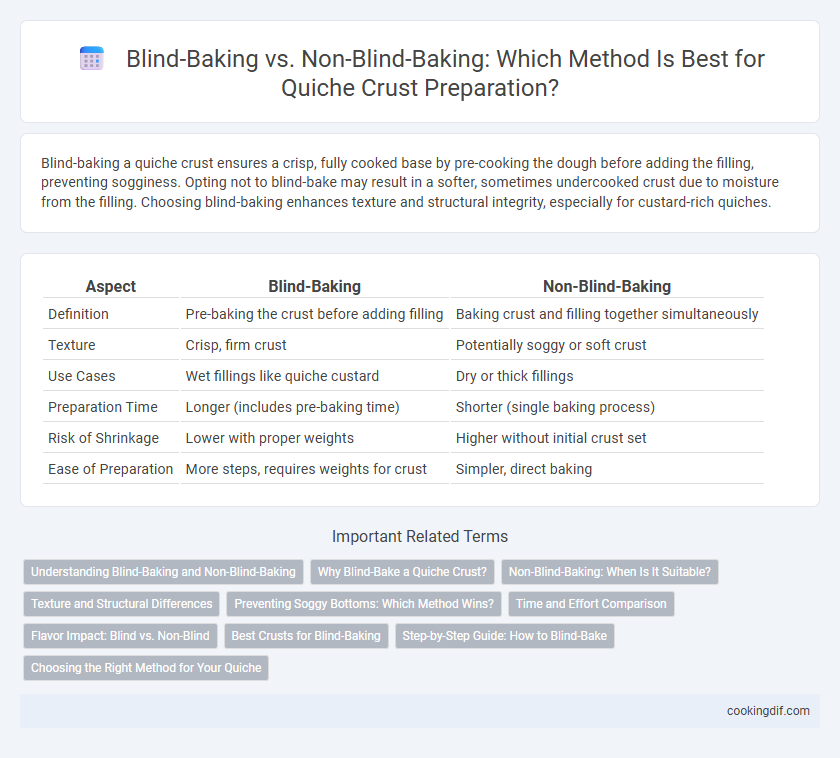Blind-baking a quiche crust ensures a crisp, fully cooked base by pre-cooking the dough before adding the filling, preventing sogginess. Opting not to blind-bake may result in a softer, sometimes undercooked crust due to moisture from the filling. Choosing blind-baking enhances texture and structural integrity, especially for custard-rich quiches.
Table of Comparison
| Aspect | Blind-Baking | Non-Blind-Baking |
|---|---|---|
| Definition | Pre-baking the crust before adding filling | Baking crust and filling together simultaneously |
| Texture | Crisp, firm crust | Potentially soggy or soft crust |
| Use Cases | Wet fillings like quiche custard | Dry or thick fillings |
| Preparation Time | Longer (includes pre-baking time) | Shorter (single baking process) |
| Risk of Shrinkage | Lower with proper weights | Higher without initial crust set |
| Ease of Preparation | More steps, requires weights for crust | Simpler, direct baking |
Understanding Blind-Baking and Non-Blind-Baking
Blind-baking involves pre-cooking the quiche crust without filling to ensure a crisp, golden base that prevents sogginess from custard mixtures. Non-blind-baking means filling the crust raw and baking it together, resulting in a softer, sometimes-moist crust that absorbs flavors. Choosing between these methods depends on desired texture and filling moisture content in quiche preparation.
Why Blind-Bake a Quiche Crust?
Blind-baking a quiche crust prevents sogginess by creating a fully cooked, crisp base that supports the wet filling without becoming soggy. This technique sets the crust's structure, ensuring it holds its shape and provides a desirable texture contrast to the creamy custard interior. Skipping blind-baking often results in a undercooked, doughy crust that diminishes the quiche's overall quality.
Non-Blind-Baking: When Is It Suitable?
Non-blind-baking the quiche crust is suitable when the filling has a high moisture content and requires minimal baking time, allowing the crust to cook fully alongside the filling. This method works best with custard-based fillings that need gentle baking, preventing the crust from becoming overly crisp or dry. Avoid non-blind-baking for wet fillings that might cause a soggy bottom, but it's ideal for delicate fillings where a tender, flaky crust is desired.
Texture and Structural Differences
Blind-baking a quiche crust creates a firmer, crispier texture that prevents sogginess by pre-cooking the dough, ensuring a sturdy base for the filling. Non-blind-baked crusts tend to absorb moisture from the custard and vegetables, resulting in a softer, sometimes slightly undercooked texture with less structural integrity. Choosing blind-baking is essential for maintaining a clear separation between the crunchy crust and smooth filling, enhancing the overall eating experience.
Preventing Soggy Bottoms: Which Method Wins?
Blind-baking involves pre-baking the quiche crust without filling, creating a firm barrier that prevents moisture from seeping in and causing soggy bottoms. Non-blind-baking, where the crust is baked with the filling, often leads to a softer, sometimes soggy base due to trapped moisture released during baking. For a crisp, flaky crust that resists sogginess, blind-baking is the preferred method in quiche preparation.
Time and Effort Comparison
Blind-baking a quiche crust requires pre-baking the pastry shell, typically taking about 15-20 minutes, which adds extra preparation time but ensures a crisp, non-soggy base. Non-blind-baking skips this step, saving time and effort but risks a soggy crust due to the wet filling. Choosing blind-baking involves a bit more effort upfront but results in a firmer texture, while non-blind-baking simplifies the process at the potential cost of crust quality.
Flavor Impact: Blind vs. Non-Blind
Blind-baking enhances quiche crust flavor by creating a crisp, golden base that prevents sogginess and intensifies buttery notes. Non-blind-baking can result in a softer, sometimes undercooked crust with a less distinct texture, potentially diluting the overall rich, savory taste. Choosing blind-baking ensures a firmer crust that complements the creamy filling, improving the quiche's flavor balance.
Best Crusts for Blind-Baking
Blind-baking is essential for quiches with custard fillings to prevent soggy crusts by pre-baking the pastry until it is firm and lightly golden. The best crusts for blind-baking are pate brisee, pate sucree, and shortcrust pastry due to their sturdy texture and ability to hold fillings without becoming soggy. Using pie weights or dried beans during blind-baking maintains crust shape and ensures even baking, producing a crisp and flaky base perfect for savory quiche fillings.
Step-by-Step Guide: How to Blind-Bake
Blind-baking a quiche crust prevents sogginess by pre-cooking the dough before adding the filling, ensuring a crisp and sturdy base. To blind-bake, first, roll out the crust and fit it into the pie dish, then prick the bottom with a fork to avoid bubbles. Line the crust with parchment paper, fill with pie weights or dried beans, bake at 375degF for 15 minutes, remove the weights and paper, then bake for an additional 5-7 minutes until golden.
Choosing the Right Method for Your Quiche
Blind-baking the quiche crust ensures a crisp, golden base by pre-cooking it before adding the filling, preventing sogginess from custard moisture. Non-blind-baking allows the crust to bake simultaneously with the filling, resulting in a softer, more integrated texture. Choose blind-baking for a firm, flaky crust ideal for wet fillings, and non-blind-baking for a tender, cohesive quiche experience.
blind-baking vs non-blind-baking for crust preparation Infographic

 cookingdif.com
cookingdif.com